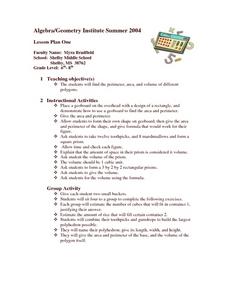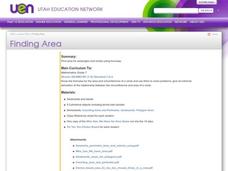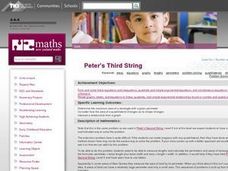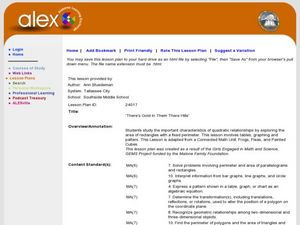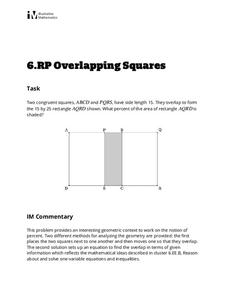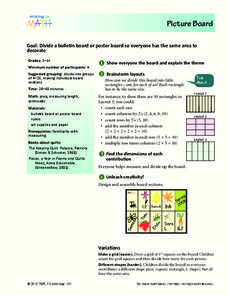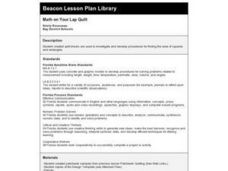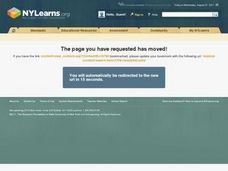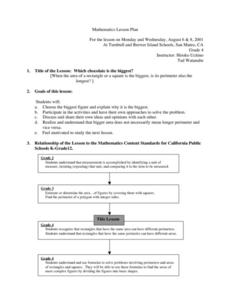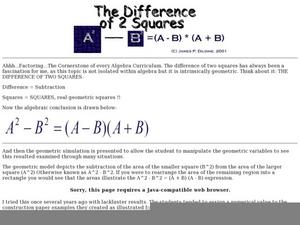Curated OER
Lesson One: Perimeter, Area, Volume
Learners explore perimeter, area and volume. Using geoboards, toothpicks, and marshmallows, students create specific shapes. They are directed to use formulas to find the volume, area, and perimeter of the created shapes. In groups,...
Curated OER
Area and Perimeter
Students discover and apply the formula for the area and perimeter of rectangles and squares. They draw the shapes on graph paper and create tables that include their information.
Curated OER
Robot Area
Students calculate the area of different polygons. In this geometry lesson, students explore polygons based in their shape and number of sides. They find the formula for the area and use each specific formula for each shape.
Curated OER
Perimeter and Area of a Rectangle
Sixth graders fill out worksheets to find the perimeter and area of rectangles. In this perimeter and area lesson plan, 6th graders color in the area and measure the perimeters.
Curated OER
Complexity Madness
Discuss different techniques for finding the area of a geometric shape, with a great visual guide. Using a real life example, learners calculate the area of a rectangle and a square.
Curated OER
Finding Area
Seventh graders explore the concept of area. For this area lesson, 7th graders determine what measurements are necessary to find the area of a rectangle and circle. Students use area formulas to calculate area or rectangles and circles.
Curated OER
Investigation-Looking at Polygons
Eighth graders plot points and investigate polygons. They locate a point, using ordered pairs of integers on the coordinate plane. Students compare geometric measurements and computations on coordinate axes as they are applied to...
Curated OER
Peter's Third String
Explore the solution to a word problem involving area and perimeter. Learners read and discuss how to approach the problem. In small groups, they determine the maximum area of a rectangle with a given perimeter using a piece of string....
Alabama Learning Exchange
There's Gold in Them There Hills
Need to build a laser fence on Mars? In this cute maximizing-area lesson, young explorers pretend to be prospectors on Mars and must determine the best way to use 20 meters of fencing in order to maximize their area. In addition,...
Illustrative Mathematics
Equal Area Triangles on the Same Base II
A deceptively simple question setup leads to a number of attack methods and a surprisingly sophisticated solution set in this open-ended problem. Young geometers of different strengths can go about defining the solutions graphically,...
Curated OER
Finding Area
Fourth graders explore how to find the area of a rectangular object. As a class, they discuss definition of area and strategies for finding area. The teacher models finding the area of an object by counting squares. Students observe...
Curated OER
Perimeter and Area
Fifth graders identify the area and perimeter of a rectangle. In this perimeter lesson, 5th graders use geoboards and rubber bands to construct various rectangles. Students use the formula to calculate area and perimeter of the...
Illustrative Mathematics
Overlapping Squares
The objective of this activity is to find the percent of the area of a two squares overlapping. Mathematicians find the ratio of area for the part that overlaps to the rectangle formed. The final answer is a percent as a rate per 100....
Curated OER
Picture Board
Learners divide a poster board so everyone gets the same amount of area to decorate. Youngsters talk about the different ways to divide a rectangle. They measure their lines to make sure that each piece is equal and then decorate their...
Curated OER
Lesson 9-3 Practice A: Composite Figures
In this composite figures worksheet, students solve twelve short answer problems. Students find the area of figures composed of various polygons given a sketch of the figure with side lengths labeled.
Curated OER
Math On Your Lap Quilt
Get creative juices flowing when you allow groups to figure out a procedure for how to find the area of squares and rectangles. They may use the individual patchwork blocks, or they may design one using the Design Template.
Curated OER
Rectangular Gardens Within A Given Perimeter
Sixth graders design rectangular gardens with a given perimeter and generalize how to maximize the area Students applying the formulas for perimeter and area of polygons. They analyze length, area, and volume and make relationships...
Curated OER
Investigation Designing a Patchwork Quilt
Fourth graders practice calculating area by creating a classroom quilt. Students are given a 6x6 inch square material they design based on a classroom theme. A sample of the class quilt is created using graph paper so students may...
EngageNY
Ratios of Fractions and Their Unit Rates 2
Remodeling projects require more than just a good design — they involve complex fractions, too. To determine whether a tiling project will fit within a given budget pupils calculate the square footage to determine the number of...
Curated OER
Which Chocolate Is The Biggest?
Students investigate the concepts of area and perimeter with the use of chocolate bars. They calculate the perimeter and area of different size rectangle chocolate bars and record the statistics. Then students make a visual comparison...
Curated OER
The Difference of 2 Squares
Students factor a difference of two squares. In this factoring a difference of two squares activity, students use manipulates cut from a piece of paper to illustrate the difference of two squares. Students illustrate the...
Curated OER
Finding Areas of Plane Figures
Students compute areas of squares, rectangles, and so on and summarize the formulas for computing areas and explain how the formulas are derived and understand the reasoning behind them.
Curated OER
Area of Complex Figures
Fifth graders use formulas for calculating areas of squares and rectangles to find area of complex figure, compare their own ideas with their classmates' ideas, and recognize that there are multiple methods for finding area of complex...
Curated OER
Area
Students examine the mathematical concept of area. These activities and discussions may be used to develop students' understanding of this mathematical concept and will enable students to calculate the area of a random shape on a grid.
